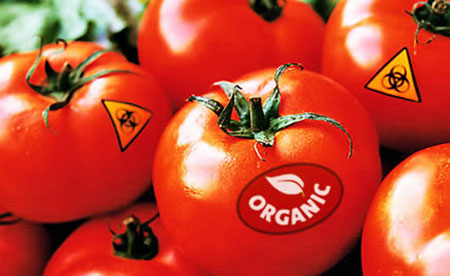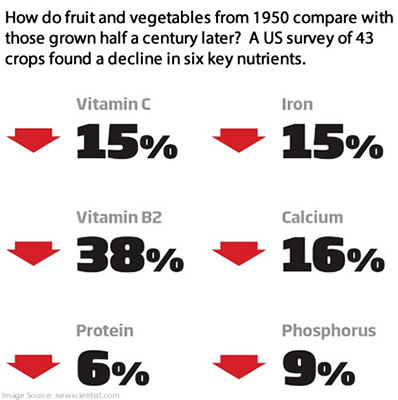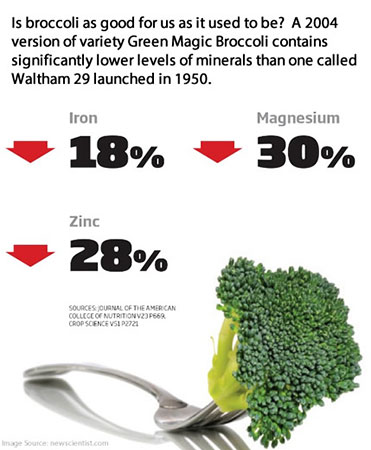|

by Marco Torres
October 19, 2015
from
PreventDisease Website
-
What if our food has been
getting less and less nutritious?
-
What if modern intensive farming
methods - many of which solved malnutrition problems when
they were first introduced - have affected the mineral and
vitamin content of what we eat?
-
Could having a constant supply
of varied produce and introducing
genetically modified foods
be compromising nature's goodness?

Whether it be vegan, low carb, paleo, or any other diet, the quest
for the healthiest method of eating shows no sign of abating, yet
all have considerable controversy.
We know more than ever about what food
does to the body and the importance of
antioxidants,
healthy fats
and a low
glycaemic index.
Things have changed so much since the wisdom of our ancestors was
lost or ignored.
-
Wild dandelions, once a springtime treat for Native
Americans, have seven times more phytonutrients than spinach, which
we consider a "superfood."
-
A purple potato native to Peru has 28
times more cancer-fighting anthocyanins than common russet potatoes.
-
One species of apple has a staggering 100 times more phytonutrients
than the Golden Delicious displayed in our supermarkets.
Were the people who foraged for these wild foods healthier than we
are today?
They did not live nearly as long as we
do, but growing evidence suggests that they were much less likely to
die from degenerative diseases, even the minority who lived 70 years
and more. The primary cause of death for most adults, according to
anthropologists, was injury and infections.
Some of the most eye-catching work
in this area has come from Donald Davis, a now-retired
biochemist at the University of Texas.
In 2011,
he compared the nutrients in US crops from 1950 and 2009, and
found notable declines in five nutrients in various fruits,
including tomatoes, eggplants and squash. For example, there was a
43 per cent drop in iron and a 12 per cent decline in calcium.
This was in line with his 1999 study -
mainly of vegetables -
which found a 15 per cent drop in vitamin C and a 38 per cent fall
in vitamin B2.

Fruit and vegetables grown have shown
similar depletions.
A 1997 comparison of
data from the 1930s and 1980s found
that calcium in fresh vegetables appeared to drop by 19 per cent,
and iron by 22 per cent. A
reanalysis of the data in 2005 concluded that 1980s
vegetables had less copper,
magnesium and sodium, and fruit less copper, iron and potassium.
Genetically modified
organisms (GMOs) in food have also alarmed researchers on distinct
differences between organic and GMO produce. Higher antioxidant
levels, lower pesticide loads, better farming practices all lead to
a more nutritious end product when choosing organic over GMO foods.
For
example, tomatoes grown by organic methods
contain more phenolic compounds than those grown using
commercial standards.
That
study - published in the Journal of Agricultural and Food Chemistry
- analyzed the phenolic profiles of Daniela tomatoes grown either
using 'conventional' or organic methods, finding that those grown
under organic conditions contained significantly higher levels of
phenolic compounds than those grown conventionally.
Other findings published in the Journal of
Agricultural and Food Chemistry showed that
organically produced apples have a
15 percent higher antioxidant capacity than conventionally produced apples.
Davis and others blame agricultural
practices that emphasize quantity over quality.
High-yielding crops produce more food,
more rapidly, but they can't make or absorb nutrients at the same
pace, so the nutrition is diluted.
"It's like taking a glass of orange
juice and adding an equal amount of water to it. If you do that,
the concentration of nutrients that was in the original juice is
dropped by half," says Davis.
But the idea that modern agriculture
produces crops that are less nourishing remains controversial, and
"then and now" nutritional comparisons have been much criticized.
The differences found may be down to
older, less accurate methods of assessing nutrition, and nutrient
levels can vary widely according to the variety of plant, the year
of harvest and the time of harvest.
Contrary to frequent claims that there is no evidence of dangers to
health from GM foods and crops, peer-reviewed studies have found
harmful effects on the health of laboratory and livestock animals
fed GMOs. Effects include toxic and allergenic effects and altered
nutritional value.
Other studies have sought to get round this by comparing old and new
varieties of a crop grown side by side. In 2011, researchers at the
US Department of Agriculture measured the concentrations of 11
minerals in 14 commercial varieties, or cultivars, of broccoli
launched between 1950 and 2004.
They found no clear relationship between
mineral levels and the year that a particular cultivar was released,
but there was evidence of a dilution effect:
bigger broccoli heads favored today
had
lower levels of some
minerals relative to a 1950 variety called Waltham 29.
But, as the study also noted, Waltham 29
is less tough than modern cultivars and so would be unlikely to
succeed if grown in the same way.

And there lies the rub.
Even if the arrival of intensive
agriculture has meant that our vegetables contain slightly less
nutrients than those our grandparents ate, it has also led to a huge
increase in food supply, which has undoubtedly had a positive effect
on our diet and health.
"Some evidence suggests that some
nutrients have fallen, particularly trace elements such as
copper in vegetables," says Paul Finglas, who compiles
nutritional data on UK food at the Institute of Food Research in
Norwich.
"Foods are now bred for yield, and
not necessarily nutritional composition. But I don't think that
is a problem, because we eat a wider range of foods today than
we did 10 years ago, let alone 40 years ago".
Other crops are also getting subtly less
nutritious.
The introduction of semi-dwarf,
higher-yielding varieties of wheat in the green revolution of the
1960s means that modern crops contain lower levels of iron and zinc
than old-fashioned varieties.
Each fruit and vegetable in our stores has a unique history of
nutrient loss, and there are two common themes.
Throughout the ages, our farming
ancestors have chosen the least bitter plants to grow in their
gardens. It is now known that many of the most beneficial
phytonutrients have a bitter, sour or astringent taste. Second,
early farmers favored plants that were relatively low in fiber and
high in sugar, starch and oil.
These energy-dense plants were
pleasurable to eat and provided the calories needed to fuel a
strenuous lifestyle. The more palatable our fruits and vegetables
became, however, the less advantageous they were for our health.
And as farmers strain to feed ever more
mouths in the face of environmental change, the problem may become
worse.
Last year, researchers at Harvard University warned that
crops grown in the future
will have significantly less zinc
and iron, due to rising levels of carbon dioxide from fossil fuel
use.
The team grew 41 different types of
grains and legumes, including wheat, rice, maize, soybeans and field
peas, under CO2 levels crops are likely to experience 40 to 60 years
from now. They found that under these conditions, wheat had 9 per
cent less zinc, 5 per cent less iron and 6 per cent less protein
than a crop grown at today's CO2 levels.
Zinc and iron - but not protein - were
also lower in legumes grown under elevated CO2.
A 2003 study evaluated the nutritional
content of
broccoli kept in conditions
that simulated commercial transport and distribution:
film-wrapped and stored for seven days at 1°C,
followed by three days at 15°C to replicate a retail environment.
By the end, the broccoli had lost between 71 and 80 per cent of its
glucosinolates - sulphur-containing compounds shown to have
cancer-fighting properties - and around 60 per cent of its
flavonoid antioxidants.
Many kinds of mass-produced fruit and
veg - most famously tomatoes - are picked unripe so that they bruise
less easily during transit. They are then sprayed with ethylene to
ripen them.
Some studies suggest that
tomatoes harvested early have lower
antioxidant activity and less flavor.
"If a fruit is left on a plant until
the end of its life cycle, it's able to recycle all the energy
from the plant," says Wagstaff. "If you pick it early you
truncate that process and get less sugars into the fruit, which
are needed to bind the nutrients."
Supermarket tomatoes are often labeled
as "vine-ripened", but that doesn't always mean what you hope, she
says.
"It may be ripened on the vine but
the vine may not have been attached to the plant."
However, Wagstaff stresses that the
downsides of early picking are small and an unavoidable consequence
of consumer demand.
"If you pick a tomato that you have
grown at home, it tastes fabulous because it's absolutely ready
to eat," she says.
"But there's no way you could do
that at a commercial level because of the bruising that would
occur if ripe fruits were transported through a typical supply
chain. There has to be a compromise somewhere."
Another complication is that each method
of shipping and storing foods has different effects on the compounds
they contain.
Vitamin C, for example, breaks down in
the dark, whereas glucosinolates - found in vegetables like broccoli
and cabbage - deplete in the light.
"That's one of the problems with
horticulture," says Wagstaff. "By its very nature you have an
enormous diversity of genera and species. In an ideal world,
each one would have a tailored supply chain."
Peas can lose half of their vitamin C in
the first 48 hours after harvesting, but if frozen within 2 hours of
picking they retain it.
"Frozen peas are much more
nutritious than peas you buy ready to shell," says Catherine
Collins, principal dietician at St George's Hospital in London.
What's more, frozen foods often have
fewer additives.
"Freezing is a preservative," she
says. "Any loss of nutrients must be weighed against the fact
that these products may encourage people to eat better overall"
Similarly, processing has become a
maligned word in the context of food, but there are some cases where
it enhances a food's health benefits. In fact, you arguably get more
benefits from processed tomatoes, such as in purees, sauces or ready
chopped in cans, than fresh.
Although salad leaves that have been
picked and stored for several days before being eaten are
a bit less nutritious than a
freshly harvested lettuce, chilling
and using packaging to reduce oxygen exposure
may slow the nutrient loss.
And any loss of nutrients must be
weighed against the fact that these products may encourage people to
eat better overall.
"There is a chance that ready
prepared vegetables may have a lower content of some vitamins,"
says Judy Buttriss, director general of the British Nutrition
Foundation in London.
"But if their availability means
that such vegetables are consumed in greater quantities, then
the net effect is beneficial."
The bottom line is that although aspects
of today's food production, processing and storage might make what
we eat a bit less nutritious, they are also making foods more
available - and this is far more important.
The majority of us
consume far less fruit and vegetables than we ought to.
We eat too much fat, sugar and salt and
not enough oily fish.
"The most important thing you can do
is eat more fruits, vegetables and wholegrains, and cut down on
highly refined, human-made foods, vegetable oils and added
sugars," says Davis.
"If you're worrying about nutrient
losses from cooking or whether your food is straight from the
farm - those differences are minor compared to the differences
you'd get from eating unprocessed foods."
What's
really on your plate
How
have modern farming methods affected the nutrients in common
foods?
Beef
Beef from cattle reared outdoors on grass
is less fatty and contains more omega-3 fatty acids
than cattle reared indoors and fed mainly grain. However,
consumers preferred the taste of latter, according to a 2014
study.
Pasta
Today's pasta might be less
nutritious thanks to modern,
fast-growing wheat varieties
introduced in the 1960s. Levels of zinc, iron and magnesium
remained constant in wheat grain from 1865 to the mid-1960s,
then decreased significantly as yields shot up.
Carrots
Carrots from the 1940s
contained less than half
the vitamin A levels of carrots grown in the US 50 years
later. The reason? A preference
for more orangey carrots. The color comes mainly from the
pigment beta-carotene, which the body can use to make
vitamin A.
Milk
Milk from cows reared the
old-fashioned way - mainly feeding on grass outdoors - has a
better nutritional profile
of proteins, fatty acids and antioxidants than milk from cows reared indoors and fed
intensively.
Bread
Humans have been making bread for 10,000 years, but the way
we do it
has changed dramatically in the last half-century.
In 1961, a new method of
mass-producing bread was devised at the Chorleywood
laboratories, just north of London. It used extra yeasts,
additives called processing aids and machinery to slash
fermentation times, so a loaf could be made in just a few
hours.
Around 80 percent of bread consumed is now made this
way.
But there are concerns that such
methods have altered the digestibility of bread, and this
may explain why many people with irritable bowel syndrome
and gluten sensitivity name bread as a trigger. For a
significant subset of those with IBS, the condition is
thought to be linked to gut bacteria reacting to fermentable
foods, causing gas and bloating.
Last year, Jeremy Sanderson at
King's College London and colleagues
compared the effects of
fast and slow-fermented breads
on gut microbiota from donors with IBS and those free from
it. They found that sourdough bread - which is left to rise
for several hours using its natural yeasts - produced
"significantly lower cumulative gas" in the IBS donors'
microbiota than fast-fermented bread.
The theory is that if bread is
left to ferment for longer, its carbohydrates will reach the
gut in a predigested state and gut bacteria won't react so
much.
"If you under-ferment bread
and add a lot of yeast, it's hardly surprising this will
set up problems for people who have a problem with
fermentation in their gut," says Sanderson.
Slow-fermented breads may
benefit other groups too: sourdough produces a lower glucose
response in the body than other breads. What's not yet clear
is whether eating slow-fermented breads would lead to a
general improvement in the gut flora of healthy people.
"That's difficult, but it's
a reasonable hypothesis," says Sanderson. "After all,
bread-making probably evolved to match what the gut
could cope with."
If modern, high-intensity farming is
causing food to lose some of its goodness, could organic food
offer an alternative?
For many consumers the answer is
yes...
Sources
|




